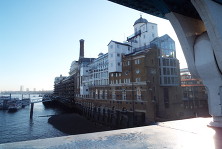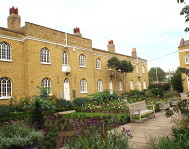








Clink Street
Clink Street is an atmospheric narrow cobbled street that runs parallel to the River Thames from the Anchor Tavern to Southwark Cathedral. On the south side are the remains of Winchester Palace with the wonderful rose window and opposite are some very handsome renovated Victorian warehouses. The street is named after the prison attached to the medieval Winchester Palace which became known as ‘The Clink’, probably an onomatopoeic word derived from the noise made by manacles. The area became known as the Liberty of the Clink and was under the jurisdiction of the Bishop of Winchester for all but the most serious crimes. Those who had broken the laws of the manor were thrown into Clink Prison, a very unpleasant place which was mostly beneath the water level. Many of those imprisoned there were prostitutes from the “stews”
(brothels) and stew-holders as well as those arrested for crimes associated with the stews such as drunkenness, brawling and petty crime. Prisoners were generally only kept there until they came to trial. The stews were abolished by Henry VIII in 1546.
During the reign of Henry’s daughter Mary I, who restored the country to Catholicism, the prison was used for the imprisonment of Protestants. The imprisoned Protestants were possibly treated more harshly than other prisoners whilst they were in The Clink awaiting execution, often by burning. The religious climate changed when Elizabeth I came to the throne when The Clink was used to imprison recusants, Catholics who maintained their faith. However, as ever in prison of those times, money was able to buy comfort and a greater freedom. Extreme Protestants were also imprisoned in the Clink during Elizabeth’s reign. Called Brownists after the headmaster of St Olav’s Grammar School, or Independents, they were the forerunners of the Puritans. Henry Burrowe, John Greenwood and John Penry were imprisoned in the Clink in 1593 and subsequently executed. Members of the same church were to set sail on the Mayflower in 1620. Gradually the prison fell into disuse and it was not rebuilt after the Gordon Rioters burned it down in 1780.
By the middle of the 17th century the riverside was already built up with tenements and brewhouses, and by 1795 the street had been further industrialised. There were wharves and factories built to the very edge of the river. These included coal wharfs, a corn wharf, warehouses, a mustard factory and a dye-house. There was another dye house next to Winchester Palace which had largely fallen down by this time and that which remained had been built around. In 1814 a great fire that had started in the mustard factory destroyed large parts of warehouses built on the palace site. Entire walls were revealed, including a complete cross-wall of the Great Hall containing the rose window. Much of what was revealed by the fire either fell down or was subsequently demolished but the building’s owner decided to preserve the wall containing the rose window as he rebuilt new warehouses around it. A map of 1872 shows flour and hop warehouses built over the site of the Palace.
The Victorian warehouses on the river’s edge were built during the early to mid 19th century. They form a continuous line 5 to 6 storeys high and include Clink Wharf, Winchester Wharf, Horseshoe Wharf and Pickford's Wharf. Pickford's Wharf was built in 1864 by wharfingers Fitch and Cozens and stored goods such as flour, hops and seeds. Fitch and Cozens built a further warehouse on the other side of Clink Street which was accessed from the warehouse on the north side by iron bridges that crossed Clink Street at high level. Pickfords & Co bought the buildings at the end of the nineteenth century and in 1921 they were purchased by Hay’s Wharf Limited who already owned a large stretch of warehousing along the river from London Bridge to Tower Bridge.
The demise of the London docks and bomb damage led to the warehouses falling into disuse and Clink Street and the surrounding area was deserted. It was designated a Conservation Area in the mid 1970s. Some warehouses, including Pickfords Warehouse on the south side of Clink Street were demolished and revealed not just further remains of Winchester Palace but beneath the Palace the remains of a large Roman building, probably a bath house for use by military personnel. The 14th century rose window, which had been exposed again by bombings in the second world war, was in a burnt and ruinous state. It was restored in 1972 and the remains of the Palace are Grade II* listed.
Today, Clink Street is a busy pedestrian thoroughfare and the warehouses successfully converted into apartments, offices and studios. Though it feels almost possible to inhale the history, it is very much a regenerated urban environment for the 21st century.
Web discoveries
- UK Casino Not On Gamstop
- UK Casino Not On Gamstop
- Non Gamstop Casino
- Casinos Not On Gamstop
- Non Gamstop Casinos
- Non Gamstop Casinos
- Non Gamstop Casino
- Casino Sites Not On Gamstop
- Slots Not On Gamstop
- Casinos Not On Gamstop
- UK Betting Sites Not On Gamstop
- UK Casino Not On Gamstop
- Best Non Gamstop Casinos
- Betting Sites
- Non Gamstop Casino Sites UK
- Best Non Gamstop Casinos
- Non Gamstop Casino
- Casinos Not On Gamstop
- Non Gamstop Casino Sites UK